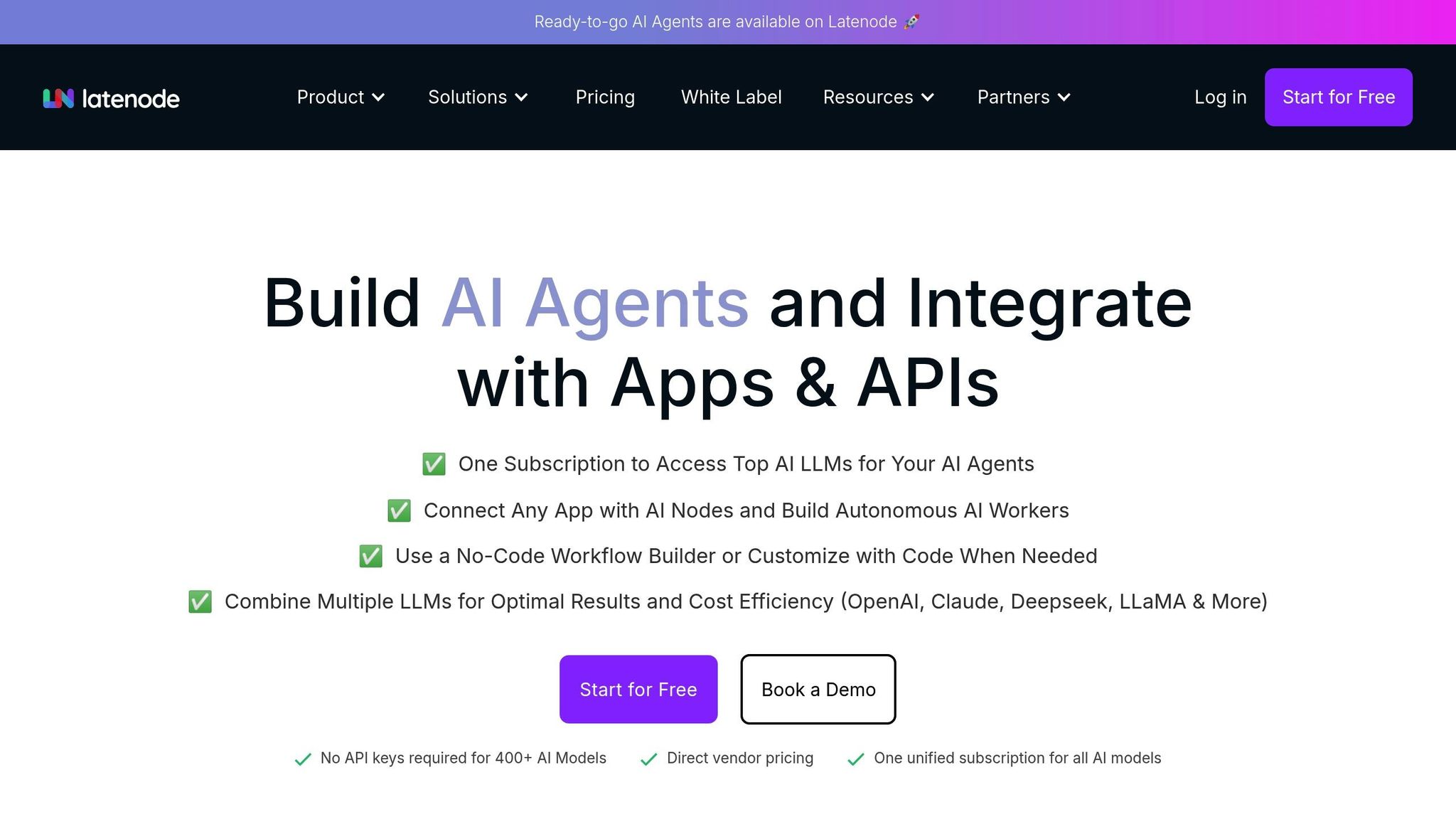


Custom AI workflow assistants are transforming how businesses handle repetitive tasks, offering smarter, more efficient ways to manage operations. By combining artificial intelligence with workflow automation, these systems go beyond basic task execution, enabling businesses to process unstructured data, make decisions, and integrate tools seamlessly. Platforms like Latenode make this accessible with features like a visual workflow builder, 300+ integrations, and 200+ AI models. Whether it's automating customer support, streamlining financial processes, or enhancing marketing campaigns, AI workflow assistants save time, reduce errors, and scale effortlessly to meet growing demands.
Here’s how Latenode empowers businesses to create custom solutions:
With tools like AI Scenario Helper and AI Code Copilot, users can quickly design workflows by describing goals in plain language or generating optimized code. For example, automate lead qualification by connecting Salesforce, OpenAI, and Slack, or streamline invoice processing with QuickBooks, OpenAI, and Google Sheets. These assistants operate 24/7, minimizing manual bottlenecks and ensuring consistent processes.
Latenode supports businesses at every stage, from simple automations to advanced, scalable solutions. By addressing integration challenges, consolidating data, and standardizing workflows, it helps organizations unlock the full potential of AI-driven automation. With the right tools, businesses can handle repetitive tasks more efficiently, freeing up resources for strategic growth.

Latenode simplifies complex automation tasks through five key features, providing a strong foundation for building advanced AI workflow assistants. These capabilities tackle common challenges such as integration issues, manual inefficiencies, and isolated data systems.
The visual workflow builder combines an intuitive drag-and-drop interface with the power of custom JavaScript, making it accessible to users of all skill levels. You can design workflows by connecting nodes visually and then enhance them with custom code for more advanced logic or data processing when needed.
With access to over 1 million NPM packages, you can integrate virtually any JavaScript library or API directly into your workflows. The builder also supports branching and conditional logic, enabling workflows to make real-time decisions based on live data. This dynamic adaptability ensures your AI assistants can respond intelligently to changing scenarios, rather than following rigid processes.
Latenode integrates seamlessly with leading AI models such as OpenAI, Claude, and Gemini, as well as custom models, through structured prompt management. This built-in AI support removes the need for complex external API configurations, streamlining the process of embedding AI into your workflows.
The AI Code Copilot further enhances development by generating, refining, and optimizing JavaScript code directly within your workflows. It accelerates development by automating repetitive coding tasks and offering intelligent suggestions. With access to over 200 AI models, you can experiment and switch between models easily. Structured prompt management ensures consistent AI interactions, allowing you to create reusable templates, manage multiple versions, and monitor model performance over time. These features make AI integration both efficient and scalable.
Latenode’s headless browser automation eliminates the need for third-party tools when automating web-based tasks. Whether it’s scraping data, filling out forms, navigating websites, or testing user interfaces, this feature handles it all seamlessly. This is particularly useful for businesses that rely on web applications without APIs, enabling them to automate interactions reliably and efficiently. Running in the background, the headless browser ensures tasks are completed quickly and consistently.
Latenode includes a built-in database for storing, managing, and querying structured data, simplifying the need for external database setups or complex data synchronization processes.
The platform connects to over 300 SaaS applications, databases, and APIs, including popular tools like Stripe, WhatsApp, and Notion. Pre-configured integrations and webhook triggers allow workflows to respond instantly to external events, ensuring real-time connectivity with systems that support HTTP hooks. This extensive integration capability makes it easy to unify your tools and streamline operations.
For businesses prioritizing control over their data and infrastructure, Latenode offers self-hosting options. This flexibility allows you to retain full ownership of your data while scaling operations based on execution time rather than per-task or per-user costs. This model is particularly cost-effective for organizations running high volumes of automated workflows.
These core features collectively create a robust platform for building efficient and secure AI workflow assistants. With tools for visual design, advanced AI integration, browser automation, extensive connectivity, and flexible hosting, Latenode equips businesses with the resources needed to develop automation solutions that evolve with their requirements.
Latenode makes it simple to create AI-powered workflow assistants using its intuitive visual tools and advanced AI features. Whether you're starting with basic tasks or scaling up to more complex processes, Latenode provides the flexibility you need.
The first step in building an AI workflow assistant is to clarify your automation goals and the tasks you want to automate. With Latenode's drag-and-drop visual builder, this process is straightforward. You add nodes for each task and connect them to design your workflow.
Every workflow begins with a trigger, which determines when the process starts. This could be a scheduled event, a webhook from another application, or a change in your database. Once the trigger is set, you can add action nodes to define each step. For example, you could create a lead qualification assistant that starts with a webhook, uses AI to analyze leads, updates your CRM, and sends notifications.
Latenode balances simplicity and flexibility by allowing you to combine its visual design tools with inline JavaScript. This means you can go beyond pre-built templates and integrate over 1 million NPM packages or APIs directly into your workflows. Decision nodes enable branching logic, so your assistants can adjust to different scenarios instead of following a rigid sequence.
To streamline the process further, Latenode offers AI tools like the AI Scenario Helper and AI Code Copilot, which simplify and enhance workflow creation.
Latenode's AI Scenario Helper lets you describe your automation goals in plain English, and it generates the workflow structure for you. Instead of manually configuring each step, you simply explain what you want to achieve. For instance, you could say, "Create a workflow that analyzes support tickets, prioritizes urgent ones for management, and sends automated replies for common issues." The AI will build the necessary steps, including text analysis models, conditional logic, and integration points for your support system.
The AI Code Copilot takes this a step further by assisting with JavaScript code. You can describe the functionality you need, and the Copilot will generate, refine, or optimize the code directly within your workflow. It can also review existing code to suggest improvements or fix errors. This feature speeds up development by allowing you to focus on the business logic while the AI handles technical details. The code remains editable, so you can fine-tune it as needed.
These AI tools not only save time but also make it easier to create workflows that are both efficient and adaptable.
Latenode's design flexibility shines when handling complex business processes. The platform supports a variety of triggers, including scheduled events, webhooks, database updates, and specific actions within connected applications.
The real power lies in combining triggers with branching logic. For example, an e-commerce workflow could notify the finance team about payment failures or update inventory and send order confirmations upon successful payments. Decision nodes allow workflows to evaluate multiple conditions and follow different paths based on the data.
Conditional logic in Latenode supports detailed expressions and comparisons. You can set rules based on numbers, text patterns, dates, or even AI-driven insights. For example, sentiment analysis on customer feedback could determine whether a case is routed to general support or escalated to a specialist.
Error handling is another key feature. Latenode lets you set up fallback paths for unavailable APIs, retry logic for temporary failures, and notifications for critical errors. This ensures your workflows remain reliable, even when external systems encounter issues.
Once your workflows are up and running, monitoring and debugging become essential for smooth operation. Latenode provides detailed execution logs that show what happens at each step, including the data being processed and any errors encountered.
You can trace your workflow's data path to pinpoint bottlenecks or errors. Each node's data can be inspected, and error messages provide clear insights into what went wrong. If issues arise, Latenode's debugging tools let you pause workflows, examine their current state, and even modify data before resuming. You can also rerun specific parts of a workflow without starting over, saving time during testing.
Latenode keeps a history of workflow executions, allowing you to analyze patterns and identify recurring issues. This historical data helps you optimize performance and anticipate potential problems. Alerts can also be set up for specific error conditions, so you're notified of critical issues immediately.
Beyond error tracking, Latenode offers performance monitoring tools to analyze execution times and resource usage. This helps you identify workflows that may need optimization, ensuring your automations run efficiently as your operations grow.
Deploying AI workflow assistants is just the beginning; the real challenge lies in managing and scaling them effectively as your business grows. This requires continuous monitoring, thoughtful scaling strategies, and adaptable security measures that align with your operational needs. These practices ensure your AI workflow assistants remain efficient and ready to handle growth seamlessly.
To keep AI workflow assistants running reliably, proactive monitoring and systematic debugging are essential. Tools like Latenode's execution logs and scenario history offer complete visibility into workflow performance, helping you quickly identify and address issues before they escalate.
Error handling becomes increasingly important as you scale. Latenode provides features to manage temporary glitches, minimizing disruptions to your operations. Additionally, analyzing performance metrics can reveal resource usage patterns, allowing you to make targeted adjustments for better efficiency. By streamlining management processes, you set a strong foundation for scaling and optimizing performance.
Scaling workflows efficiently requires tools that grow with your needs. Latenode's flexible integrations and management capabilities make scaling predictable and straightforward. Its pricing model is designed to accommodate growth without unexpected cost increases. Instead of charging per operation, Latenode uses a credit-based system that reflects actual execution time, ensuring scalability even as data volumes fluctuate.
The Team plan supports up to 20 simultaneous runs, while Enterprise plans can handle over 150 parallel executions. This flexibility is particularly useful for batch processing or handling traffic surges.
As workflows expand, optimizing processes becomes critical. Breaking down complex workflows into smaller, more focused segments can not only improve performance but also reduce the credits consumed, making operations more cost-effective.
As your workflows scale, maintaining strong security measures becomes increasingly important. Protecting sensitive data is a top priority, and Latenode offers a self-hosting option to enhance data integrity. Running the platform on your own infrastructure gives you greater control over resource allocation and data management, which is crucial for industries with strict data residency or compliance requirements.
Latenode follows industry-standard security practices to ensure that workflow assistants only access the data they need. Built-in credential management adds another layer of protection, safeguarding sensitive information.
Compliance with privacy regulations like GDPR and CCPA is seamlessly supported. Latenode's database includes tools for managing data retention policies, ensuring personal information is handled in line with legal requirements. Detailed system logs also aid in compliance reporting, making it easier to demonstrate adherence to data protection standards during audits.
Beyond platform-level security, it's important to regularly assess the connected services within your workflows. This ensures that every component of your AI workflows continues to meet evolving security standards, keeping your data protected as your operations grow.
AI workflow assistants can be tailored to specific roles, transforming how tasks are managed and executed across industries.
Latenode's platform offers a range of automation possibilities, empowering different teams to streamline their processes effectively.
Sales teams can enhance lead management and follow-up processes. By analyzing incoming leads, AI assigns scores based on pre-set criteria and routes high-priority prospects to the right representatives. For example: Salesforce → OpenAI GPT-4 → Slack, where AI evaluates lead quality and provides teams with personalized talking points.
Customer support teams benefit from automated ticket routing and response generation. AI categorizes tickets, recommends solutions from knowledge bases, and drafts initial replies. A typical setup might involve Zendesk → Claude 3.5 → Gmail, creating context-aware responses while keeping a human touch.
HR departments can simplify hiring and onboarding. AI can parse resumes, conduct initial assessments, and handle interview scheduling. For instance: BambooHR → Gemini Pro → Google Calendar, where AI matches applications to job requirements and schedules interviews with selected candidates.
Finance teams use AI to automate invoice processing, categorize expenses, and prepare financial reports. This reduces errors and speeds up month-end tasks. A practical workflow could include: QuickBooks → OpenAI GPT-4 → Google Sheets, where AI organizes transactions and creates preliminary financial summaries.
Marketing teams leverage automation for personalized content, campaign optimization, and lead nurturing. AI segments audiences, analyzes customer behavior, and crafts targeted messaging at scale. A common example: HubSpot → Claude 3.5 → Mailchimp, where AI generates personalized email sequences tailored to customer interactions and preferences.
These examples highlight how automation can address specific business challenges. The next step is choosing the right approach for your unique needs.
The best automation approach depends on your business's complexity and requirements.
Your choice will depend on your team's technical expertise and the specific challenges you aim to address. Start simple with visual workflows and gradually integrate code or AI as your needs evolve.
Once you've identified your automation approach, connecting Latenode to your existing SaaS tools can maximize efficiency.
Google Workspace integration helps automate document workflows. You can generate reports, summarize meetings, and keep project documentation updated. For example: Google Sheets → OpenAI GPT-4 → Google Docs, where raw data is transformed into polished reports complete with actionable insights.
Slack integration turns your communication platform into a centralized operations hub. Automate responses to channel messages, share real-time updates, and facilitate approvals using interactive buttons. A setup like Slack → Claude 3.5 → Notion can process team requests and update project databases seamlessly.
Stripe integration simplifies payment processing and customer management. When payments are processed, workflows can update records, initiate fulfillment, and send personalized communications. For instance: Stripe → OpenAI GPT-4 → Mailchimp, segmenting customers by purchase behavior and triggering targeted follow-ups.
QuickBooks integration bridges financial data with operational tools, enabling real-time insights and automated reporting. You can sync transaction data, create financial dashboards, and automate compliance tasks. A workflow like QuickBooks → Gemini Pro → Google Sheets categorizes expenses and generates budget variance reports.
Understanding how data flows between your tools and identifying where AI can make the biggest impact are key to successful integration. Focus on automations that reduce manual entry, minimize app-switching, and deliver actionable insights to drive smarter decisions.
Custom AI workflow assistants are reshaping business automation, moving beyond basic task completion to systems capable of intelligent decision-making. By incorporating these tools, businesses can boost productivity by up to 40% and cut administrative costs by as much as 20% [1][3].
Latenode stands out with its user-friendly visual builder and JavaScript support, offering seamless integration with over 300 apps and 200+ AI models. This flexibility ensures businesses can connect their entire tech ecosystems without worrying about vendor restrictions or hidden fees. For organizations in the U.S. that must comply with regulations like HIPAA and CCPA, Latenode’s self-hosting option provides the critical benefit of full data ownership.
The impact of AI workflow assistants is not hypothetical; it's already visible in real-world scenarios. For instance, Unity leveraged AI workflow automation to reduce IT support resolution times from three days to under three minutes, achieving a remarkable 91% employee satisfaction rate [2]. These aren’t minor upgrades - they represent a complete transformation in how work is approached and executed.
Latenode empowers businesses at every stage, from initial design and customization to scaling workflows over time. Start by identifying repetitive, high-impact processes and use Latenode’s visual builder to prototype solutions. As needs grow, extend workflows with advanced coding and AI-driven capabilities to maximize efficiency.
AI-driven workflow automation is no longer a distant concept - it’s happening now. Organizations that embrace these tools today will gain significant advantages in efficiency, cost control, and employee engagement. Platforms like Latenode eliminate traditional barriers to automation, making it easier than ever to implement advanced systems. The real question isn’t whether to adopt AI workflow assistants, but how quickly they can be deployed to unlock their full potential.
Latenode's self-hosting option empowers businesses to take full control of their data by enabling storage and management on their own servers, rather than depending on third-party cloud providers. This approach reduces exposure to external security vulnerabilities and ensures adherence to stringent data privacy regulations - an essential consideration for sectors like healthcare and finance.
With self-hosting, organizations can design and implement security protocols and access controls that align with their specific policies. This level of customization not only enhances data security but also provides companies with the assurance needed to meet precise compliance standards.
Latenode's AI Scenario Helper and AI Code Copilot are designed to streamline the process of creating and managing workflows. These tools take the heavy lifting out of tasks like code generation and debugging, saving both time and effort, especially for those without advanced coding skills.
With these AI-powered features, users receive intelligent, real-time suggestions that make building even complex automations faster and more efficient. By using these tools, you can fully tap into Latenode's low-code platform, crafting production-ready workflows with minimal manual intervention. This makes automation accessible and achievable, regardless of your technical background.
Latenode streamlines business processes by integrating more than 300 SaaS tools, allowing data to flow effortlessly between platforms. This connectivity removes the need for repetitive manual work, minimizes errors, and speeds up workflows, ultimately supporting quicker decision-making and boosting productivity.
With its adaptable, usage-based pricing model, Latenode is accessible to businesses of all sizes. This approach ensures companies can expand their integrations cost-effectively, making it a valuable tool for improving efficiency and driving growth without adding extra expenses.



